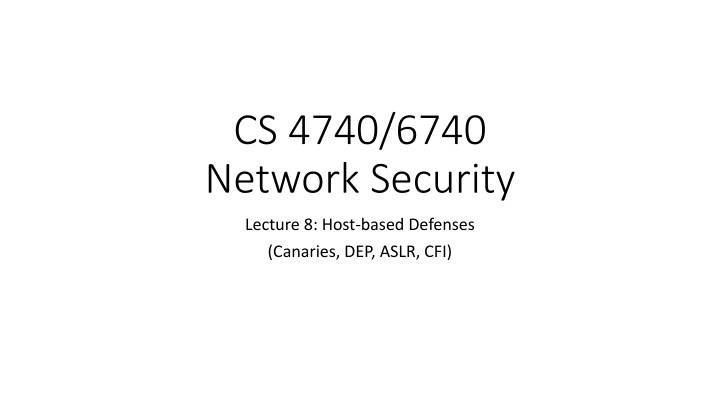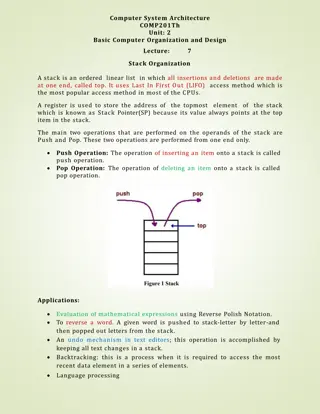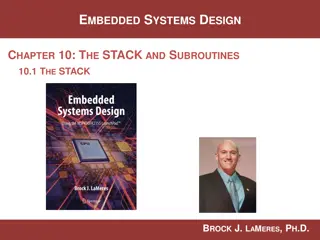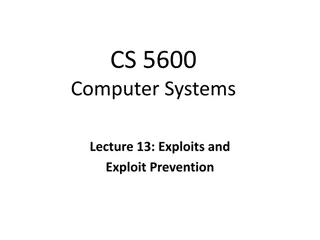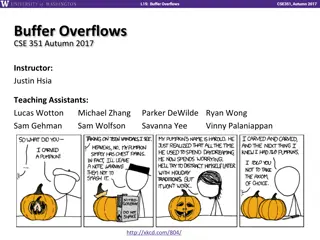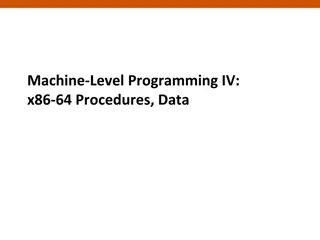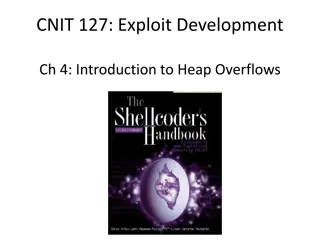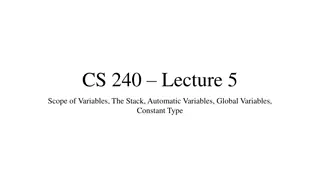Protective Measures Against Stack Overflows
Host-based defenses such as Canaries, DEP, ASLR, and CFI play a crucial role in safeguarding systems against malicious attacks. Canaries act as early warning systems, alerting to stack overflows by monitoring changes in sensitive data. By implementing stack canaries, developers can prevent buffer overflows from being successfully exploited, enhancing system security and reliability.
Download Presentation

Please find below an Image/Link to download the presentation.
The content on the website is provided AS IS for your information and personal use only. It may not be sold, licensed, or shared on other websites without obtaining consent from the author.If you encounter any issues during the download, it is possible that the publisher has removed the file from their server.
You are allowed to download the files provided on this website for personal or commercial use, subject to the condition that they are used lawfully. All files are the property of their respective owners.
The content on the website is provided AS IS for your information and personal use only. It may not be sold, licensed, or shared on other websites without obtaining consent from the author.
E N D
Presentation Transcript
CS 4740/6740 Network Security Lecture 8: Host-based Defenses (Canaries, DEP, ASLR, CFI)
Stack-Based Defenses Canaries Data Execution Prevention (DEP)
Stack Overflow Defenses 1. Don't write vulnerable code (realistic?) 2. Don't use languages that aren't memory-safe, e.g. Rust (if you can) 3. Safer APIs e.g., strlcpy, std::string 4. Shadow stacks 5. Stack canaries 6. DEP (later)
The Canary in the Coal Mine Miners used to take canaries down into mines The birds are very sensitive to poisonous gases If the bird dies, it means something is very wrong! The bird is an early warning system
Stack Canaries Stack A stack canary is an early warning system that alerts you to stack overflows Malicious shellcode Automatically added by the compiler Overflow destroys the canary, assert fails, program safely exits Stuff from previous frame int canary = secret_canary; char buf[8]; for (x = 1; x < argc; ++x) { strcpy(buf, argv[x]); num = atoi(buf); check_for_secret(num); } ... assert(canary==secret_canary); return 0; NOP sled ESP - 24 return address canary value Pointer to sled ESP - 20 ESP - 16 ESP - 12 ESP - 8 int num int x Garbage char buf[8] ESP
Canary Implementation Canary code and data are inserted by the compiler gcc supports canaries Disable using the fno-stack-protector argument Canary secret must be random Otherwise the attacker could guess it Canary secret is stored on its own page at semi-random location in virtual memory Makes it difficult to locate and read from memory
Canaries in Action [cbw@finalfight game] ./guessinggame AAAAAAAAAAAAAAAAAAAAAAA *** stack smashing detected ***: ./guessinggame terminated Segmentation fault (core dumped) Note: canaries do not prevent the buffer overflow The canary prevents the overflow from being exploited
Stack Canaries main: push rbx sub rsp, 0x110 mov rax, qword fs:0x28 mov qword [rsp+0x108], rax ; store secret on stack ; [...] mov rax, qword fs:0x28 cmp rax, qword [rsp+0x108] ; compare to stack copy jne .bad ; if not equal, bail xor eax, eax add rsp, 0x110 pop rbx ret ; everything is good? .bad: call __stack_chk_fail ; print a scary message ; load secret at fs:0x28 ; load secret
Stack Canaries How to make canaries hard to guess? Random from large domain, generated at runtime Example of a great success story for security One simple compiler flag Downsides Introduces bloat, results in worse cache behavior Incomplete coverage in popular implementations Can be defeated by information leaks
When Canaries Fail Stack ESP - 1036 ESP - 1032 ESP - 1028 ESP - 1024 Canary is left intact return address canary value Pointer to sled void my_func() { ... } Function pointer fptr int canary = secret_canary; void (*fptr)(void); char buf[1024]; fptr = &my_func; strcpy(buf, argv[1]); fptr(); assert(canary==secret_canary); return 0; Malicious shellcode Calling fptr triggers the exploit char buf[1024] NOP sled ESP
ProPolice Compiler Stack ESP - 1036 ESP - 1032 ESP - 1028 return address canary value Security oriented compiler technique Attempts to place arrays above other local variables on the stack Integrated into gcc char buf[1024] ESP - 4 ESP fptr
When ProPolice Fails void my_func() { ... } struct my_stuff { void (*fptr)(void); char buf[1024]; }; The C specification states that the fields of a struct cannot be reordered by the compiler int canary = secret_canary; struct my_stuff stuff; stuff.fptr = &my_func; strcpy(stuff.buf, argv[1]); stuff.fptr(); assert(canary==secret_canary); return 0;
Data Execution Prevention (DEP) Problem: compiler techniques cannot prevent all stack-based exploits Key insight: many exploits require placing code in the stack and executing it Code doesn t typically go on stack pages Solution: make stack pages non-executable Originally implemented by PaX on Linux Closely followed by W^X on OpenBSD Modern implementations rely on hardware support e.g., NX bit on page table entries Or, fine-grain memory tags
W^X (Segmentation) Original W^X implementation used segmentation to prevent data execution Code, data segments clustered together Code segment limit set below base offset of data segments Effective, at mitigating some exploits, but there is a price Reduces available memory
x86 Page Table Entry On x86, page table entries (PTE) are 4 bytes 31 - 12 11 - 9 8 7 6 5 4 3 2 1 0 Page Frame Number (PFN) Unused G PAT D A PCD PWT U/S W P W bit determines writeable status but there is no bit for executable/non-executable On x86-64, the most significant bit of each PTE (bit 63) determines if a page is executable AMD calls it the NX bit: No-eXecute Intel calls it the XD bit: eXecute Disable
When NX bits Fail NX prevents shellcode from being placed on the stack NX must be enabled by the process NX must be supported by the OS Can exploit writers get around NX? Of course ;) Return-to-libc Return-oriented programming (ROP)
Data Exploits and Countermeasures Return-to-libc Return Oriented Programing (ROP) Address Space Layout Randomization (ASLR) Control Flow Integrity (CFI)
Return to libc /bin/sh char ** argv 0 Ptr to string char * file Parameters for a call to execvp() Fake return addr return address Current stack frame 0x007F0A82 Example exploits thus far have leveraged code injection Why not use code that is already available in the process? execvp(char * file, char ** argv); libc Library execvp() 0x007F0A82 0x007F0000
ROP Return-oriented programming (ROP) extends return-into-libc by changing the granularity of code reuse Introduced by Shacham in 2007 Shown to be Turing complete Instead of returning to functions, ROP uses gadgets Gadgets: small sequences of instructions ending in a control transfer e.g., a return Each gadget performs a small update to the program state Execution becomes a chain of returns to gadgets
ROP Gadgets Stack
Finding Gadgets Gadgets are found by scanning memory for desirable instruction sequences Because x86(-64) has variable-length instructions, unintended instruction sequences are also possible
ROP Compilers There are several automated tools that will: 1. Locate gadgets in a target binary 2. Use them to construct a desired exploit payload Example: ROPgadget from Jonathan Salwan (Shell- Storm)
ROP Works against virtually any architecture, not just x86 Useful in many situations Non-executable memory, signed code enforcement When combined with memory disclosures, ROP is very difficult to defend against Extremely active area of research
Defending Against ROP Virtual Memory 264-1 Stack Stack Stack Region Stack Return-to-libc and ROP work by repeatedly returning to known pieces of code This assumes the attacker knows the addresses of the code in memory Key idea: place code and data at random places in memory Address Space Layout Randomization (ASLR) Supported by all modern OSes Heap Heap Region Heap Heap Code Code Region Code Code 0
Randomizing Code Placement Virtual Memory 264-1 It s okay for stack and heap to be placed randomly Example: stack is accessed relative to RSP Problem: code is typically compiled assuming a fixed load address Process 2 Addr of foo(): 0x0DEB49A3 Process 1 Addr of foo(): 0x000FE4D8 0
Position Independent Code Example Modern compilers can produce Position Independent Code (PIC) Also called Position Independent Executable (PIE) Example: 0x4004cc + 0xffffffe8 = 0x4004b4 e8 is the opcode for a relative function call Address is calculated as EIP + given value 004004b4 <func>: Global data is accessed relative to EIP int global_var = 20; 004004bf <main>: 4004bf: 55 4004c0: 48 89 e5 4004c3: 48 83 ec 10 4004c7: e8 e8 ff ff ff 4004cc: 89 45 fc 4004cf: c7 05 3f 0b 20 00 10 mov 4004d6: 00 00 00 4004d9: b8 00 00 00 00 4004de: c9 4004df: c3 push ebp mov ebp, esp sub esp, 0x10 call 4004b4 <func> mov [ebp-0x4], eax int func() { return 30; } int main() { int x = func(); global_var = 10; return 0; } [eip+0x200b3f], 0x10 mov eax, 0x0 leave ret
Tradeoffs with PIC/PIE Pro Enables the OS to place the code and data segments at a random place in memory (ASLR) Con Code is slightly less efficient Some addresses must be calculated In general, the security benefits of ASLR far outweigh the cost
ASLR Lightweight and effective defense No program recompilation required (in most cases) Transparent to benign applications Little overhead When to randomize? 1. At process creation? 2. Or, periodically e.g., after every process fork?
Security of ALSR Let's call an attempted attack with randomization guess x a probe If x is correct, the attack succeeds; if not, it fails Assume a 32 bit architecture and uniform probe distribution Scenarios Address spaces are randomized once Address spaces are randomized after each probe What is the expected number of trials required to perform a successful attack in each scenario?
No Re-Randomization Flashback to intro to probability Imagine that each probe is a ball in a bin; in total, there are 216balls Without re-randomization, a probe is equivalent to drawing a ball without replacement With re-randomization, a probe is equivalent to drawing a ball with replacement
No Re-Randomization Probability of success on the nthtrial Success Failures
No-Rerandomization Probability of success by the nthtrial
No Re-Randomization What is the expected number of trials until a successful probe?
Re-Randomization How about with re-randomization? Re-randomization only gives 1 more bit of security
ASLR Circumvention Lots of guesses (but this is inefficient) Memory disclosures Typically the target executable and libraries are known If an address of known code or data is leaked, it's simple to recover the image base Spraying (heap, JIT) Exploit any remaining fixed structures e.g., the PLT
More Randomization How about another artificial diversity defense? What if the attacker is allowed to: 1. Hijack control flow 2. Inject a payload 3. Locate and jump to the payload ...but, cannot reliably execute the payload? The attacker also assumes the target uses a particular instruction set architecture e.g., injecting an ARM payload won't work on x86_64
Instruction Set Randomization Attacker injects a payload and hijacks control flow ISR "periodically" changes the bit representation of instructions With sufficient entropy, attacks become very difficult Another example of introducing a work factor
ISR Discussion Fine-grain approach to artificial diversity Requires a large degree of support from underlying software and hardware How to efficiently execute randomized code? Implementation approaches Virtual machines (e.g., JVM) Or, hardware support Deemed not worth the cost to implement and deploy so far
Control Flow Integrity (CFI) Let's move on from randomization to fine-grained policy enforcement Control-flow integrity (CFI) Extract all possible control flow transfers from a program Enforce that only those transfers can occur during execution 4 3
CFG A program's control-flow graph (CFG) is an abstraction of all possible control-flow transfers that can be made when executing a program Directed graph where nodes represent basic blocks and edges represent jumps/calls/returns Basic blocks are contiguous sets of instructions that must execute sequentially No jumps out of a basic block except at the end No jumps into the middle of a basic block 4 4
Example CFG int main(int argc, char** argv) { if (argc < 3) { exit(0); } int ret = on_cmd(argv[1], argv[2]); if (ret) { printf("ERROR: %s\n", argv[1]); } else { printf("OK\n"); } return ret; }
CFI Implementation Many ways to implement CFI Original idea: static binary analysis and rewriting Extract a CFG from a binary program Add runtime checks on destinations of control-flow transfers Program terminated if a check fails
CFI Enforcement Return label check
CFI Overhead CFI labeled transition enforcement overhead on SPEC2000
CFI Discussion Why is this better than, e.g., DEP or ASLR? Overhead is significant Much work on more efficient, but weaker, implementations Can you always extract an accurate CFG? Is it sound? Is it a tight approximation? Still vulnerable to mimicry attacks What if adversary can implement an attack within the enforced CFG?
CFI Mimicry Attack int exec_prog(char* path) { char buf[1024]; strcpy(buf, path); return system(buf); } Assuming CFI is enforced, can the attacker perform a stack-smashing attack? What can the attacker do instead? Overflow buf, perform a return-to-libc attack that directs to system() The CFI enforcer expects exec_prog() to call system() Thus, the attack succeeds ;)
